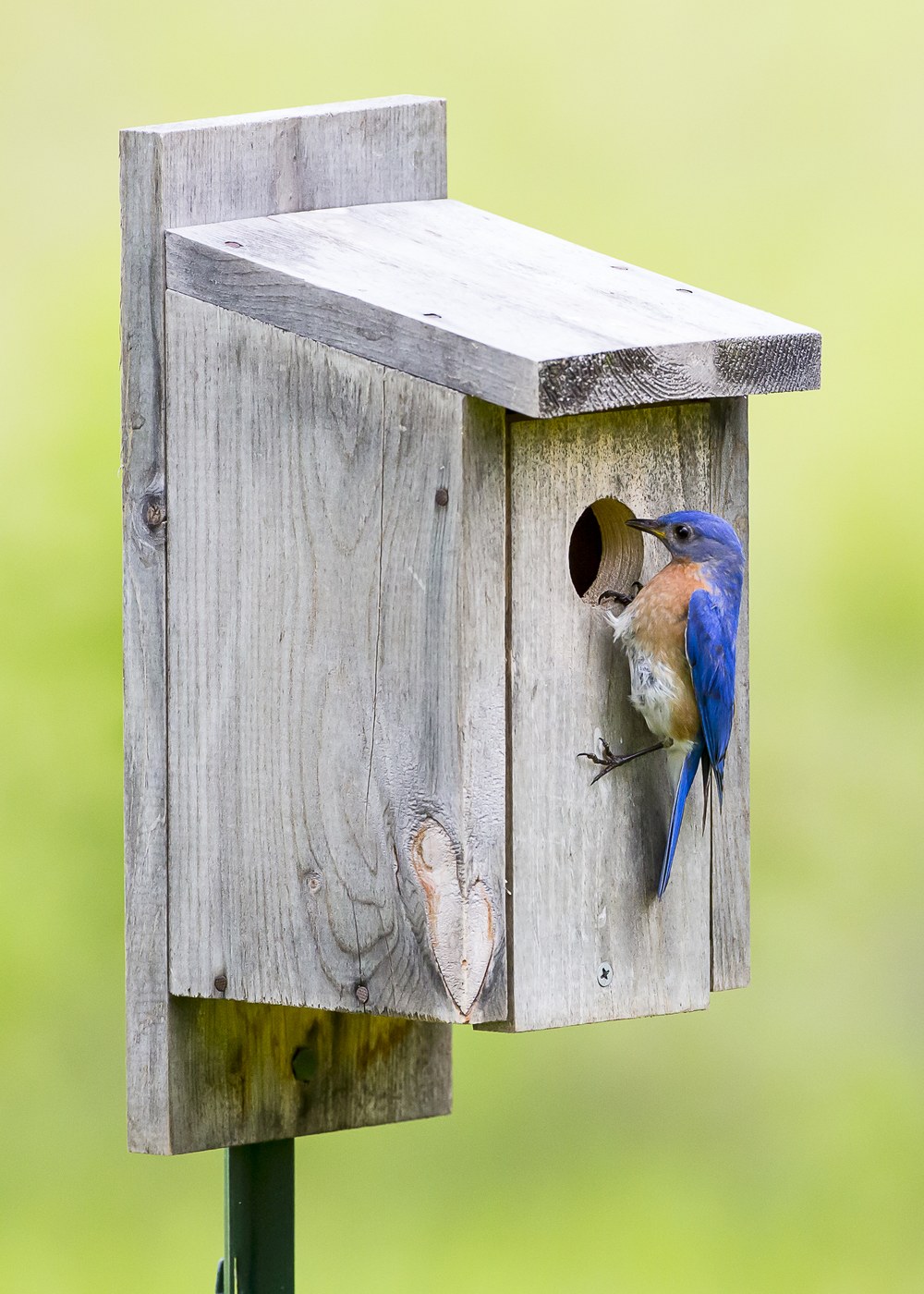Posted: October 31, 2023

A Bluebird nest box and resident male
By Jeff Osborne-Forest Stewardship Program Associate
Winter is coming. To survive the low winter temperatures, wildlife seek food and shelter in various ways. Making sure you have structures and food for wildlife through the winter months will make your woods more appealing for overwintering animals. Many birds and small mammals will stay warm in tree cavities. Some cavities form in trees due to injury to the tree and subsequent decay of wood near the injury. Other cavities are primarily excavated by several species of non-migratory birds including Black-capped Chickadees, Red-breasted Nuthatches, and woodpeckers including the Pileated, Downy, Hairy, Red-headed, and Red-bellied varieties. Some areas may be replete with trees of different species, ages, sizes, and have plenty of existing cavities; some areas may have potential for plenty of cavities in the near future; and other areas may have neither. It’s important to assess how many tree cavities exist per acre, how many cavities trees you may want to maintain for wildlife per acre, and how you can augment this with wooden boxes.
Are you about to have a forest management plan written or updated with a new inventory? If so, ask your plan writer to record snag and cavity information and summarize the results. If you prefer to walk your area and get a sense of cavities and cavity potential, there are resources which suggest a number of snags per acre to support populations of various birds, including this Penn State Extension article: . Many guides suggest having at least 5 den trees or snags per acre larger than 12 inches in diameter.
If you have forests that are mostly younger than 30 years-old, and without adequate numbers of den trees or snags, artificial shelters are a great way to increase options for winter shelter. There are great guides to construct shelters, such as the ones available from the Pennsylvania Game Commission’s Howard Nursery. They also have constructed boxes and kits for sale. Planting native evergreen trees and shrubs, if they are lacking in your area, will also be a helpful addition to increase winter habitability. Densely planted evergreens will reduce cold winds and retain snow fall which acts as insulation for many animals that frequent their boughs. If you are planting, develop a written plan that includes site preparation and planting and protection of the seedlings. Ask a forester or wildlife habitat manager to review it, and set yourself up for success.

Building shelters and hanging them is a great way to spend a rainy day with children or grandchildren.
If you are increasing animals wintering sheltering options, you may want to increase their winter food options as well. Now is a good time to assess your property to see if you have shrubs that retain fruits, or soft mast, from fall into winter. Fruits are formed now and are becoming more prominent as leaves drop. Tree and shrub species such as these can provide fruit through the cold season:
- Holly (Ilex)
- Eastern red cedar (Juniperus virginiana)
- Sumac (Rhus)
- Viburnum shrubs (Viburnum)
- Native roses (e.g., Rosa arkansana)
- Virginia creeper (Parthenocissus quinquefolia)
- Northern bayberry (Myrica pennsylvanica)
Many animals scour the ground for sustenance from seed in the winter, hard mast, and the following plants can provide it:
- Eastern white pine (Pinus strobus)
- Oaks (Quercus spp.)
- American beech (Fagus grandifolia)
- Hickory (Carya spp.)
- Walnuts (Juglans spp.)
- Many native herbaceous plants and grasses with larger seeds


On the right the cones of this eastern red cedar are nearly ripe at the end of October. On the left the northern bayberry has ripe berries in October. The fruits of both species are retained and can be eaten by animals through winter.
Penn State Extension and the PA Audubon Society just concluded a series of webinars designed to give foresters knowledge to manage forests with consideration for birds, but it is also a good resource for landowners. The webinars were recorded and can be viewed anytime.
James C. Finley Center for Private Forests
Address
416 Forest Resources BuildingUniversity Park, PA 16802
- Email PrivateForests@psu.edu
- Office 814-863-0401
- Fax 814-865-6275
James C. Finley Center for Private Forests
Address
416 Forest Resources BuildingUniversity Park, PA 16802
- Email PrivateForests@psu.edu
- Office 814-863-0401
- Fax 814-865-6275

